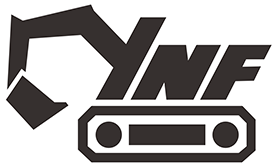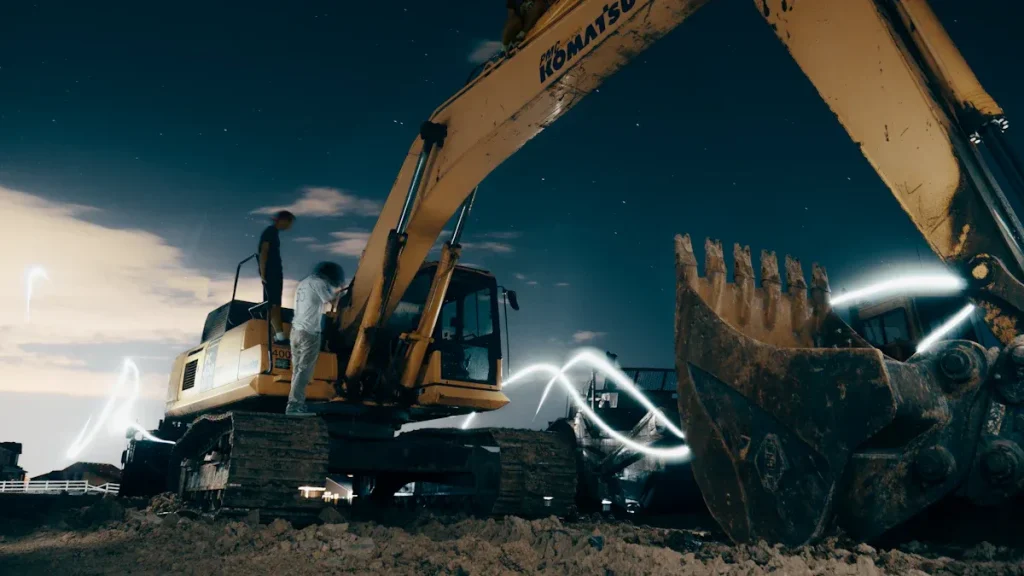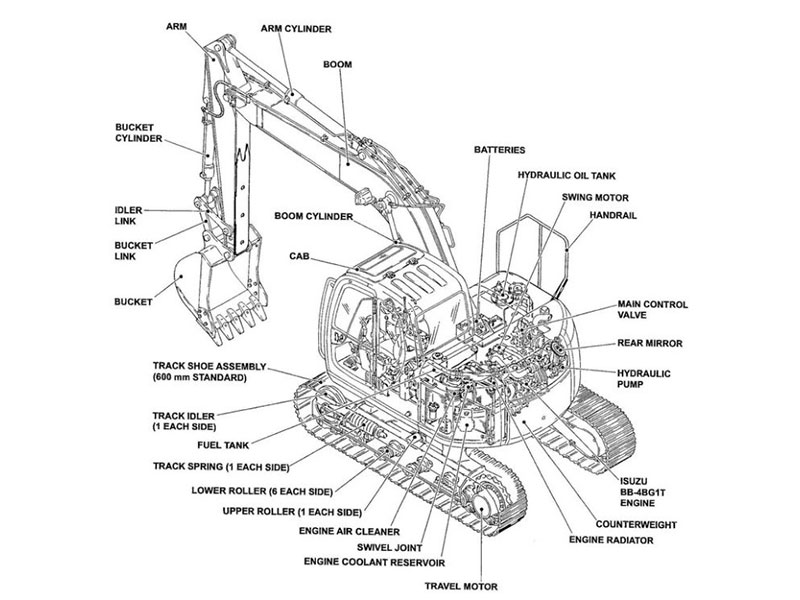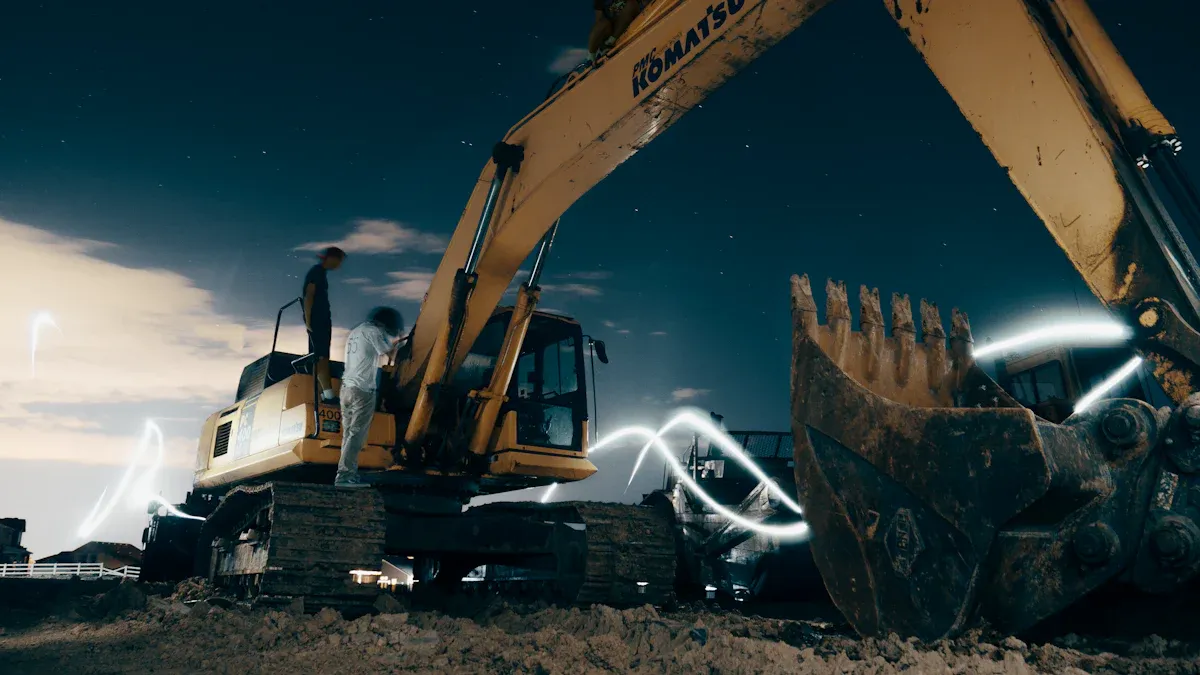
Smooth operation of an excavator happens when all its excavator parts inside work well together. The engine gives power. The hydraulic system helps control movement. The undercarriage keeps the machine steady. The cab lets you give exact commands. When you dig, the boom, arm, and bucket move together. Each part talks to the others using sensors and controls. Experts say matching the engine’s torque and using smart hydraulics saves fuel. This also helps move more material. If the excavator parts inside do not work as a team, you lose efficiency and productivity.
Key Takeaways
All excavator parts need to work well together. This helps the machine dig and lift better and faster. The engine gives power to the hydraulic system. The hydraulic system moves parts carefully and uses less fuel. Keeping up with maintenance is important. Clean hydraulic fluid helps the excavator last longer and work well. Operators must know how to use the controls. Smart hydraulics help you finish work faster and save energy. Quick couplers and strong linkages help you change tools safely. You can do more jobs with just one machine.
Excavator Parts Inside Overview

When you look at an excavator, you see many strong and smart parts working together. Each part has a special job. Here is a quick guide to the main excavator parts inside and what they do:
Part | Primary Function |
|---|---|
Engine | Powers the machine and supplies energy to the hydraulic system. |
Hydraulic System | Moves the boom, arm, and bucket with pumps, valves, and cylinders. |
Undercarriage | Supports the machine and lets it move using tracks or wheels. |
Cab | Gives you a safe and comfortable place to control the excavator. |
Boom | Reaches out from the body and holds the arm and bucket. |
Arm (Stick/Dipper) | Connects the boom to the bucket and controls digging depth and reach. |
Bucket | Digs, scoops, and carries soil or rocks. |
Counterweight | Balances the excavator during heavy lifting. |
Main Control Valve | Directs hydraulic fluid to different parts for smooth movement. |
Engine and Power
You find the engine at the heart of the excavator. It gives power to all other systems. Most engines use diesel fuel and can range from under 25 horsepower in mini excavators to over 75 horsepower in large machines. The engine makes sure you have enough force to dig, lift, and move heavy loads.
Hydraulic System
The hydraulic system is what makes the excavator strong and precise. It uses pumps, valves, and cylinders to move the boom, arm, and bucket. Hydraulic systems give you better lifting power and smoother control than other systems. This means you can handle tough jobs with less effort.
Undercarriage and Tracks
The undercarriage holds the tracks and supports the whole machine. Tracks help you move over rough ground and keep the excavator stable. Parts like rollers, sprockets, and idlers make sure the tracks run smoothly. The undercarriage lets you work safely on many types of terrain.
Cab and Controls
You sit in the cab to operate the excavator. Modern cabs have features that keep you safe and comfortable. You get a strong frame for rollover protection, wide armrests, and seats that adjust to your weight. Good lighting, easy-to-reach controls, and USB ports help you work longer without getting tired.
Boom, Arm, and Bucket
The boom, arm, and bucket are the main working tools. The boom reaches out, the arm extends or pulls back, and the bucket digs or lifts. These excavator parts inside must move together for smooth digging and lifting. You can also add attachments to the end of the arm for special tasks.
Power and Hydraulic Flow
Engine to Hydraulic System
When you start the excavator, the engine turns on. The engine does more than just move the machine. It also gives power to the hydraulic system. This system controls how the excavator moves. Here is how it works:
The engine is linked to the hydraulic pump by a drive shaft.
The drive shaft sends the engine’s power to the pump parts, like the swash plate and pistons.
The swash plate changes how far the pistons move, which changes how much hydraulic fluid moves and how much pressure builds up.
The hydraulic pump takes the engine’s energy and turns it into hydraulic energy by pressing the fluid.
A variable displacement pump lets you change the flow and pressure for each job.
Control parts, like the pilot valve and flow regulator, help match the pump’s output to what you need.
The pressurized hydraulic fluid then moves the cylinders and motors, making the excavator parts inside work.
This setup gives you strong, smooth, and exact control over the excavator.
Hydraulic Cylinders and Valves
Hydraulic cylinders are like the muscles of the excavator. When pressurized fluid goes into a cylinder, it pushes a piston. This makes the boom, arm, or bucket move. You can lift, dig, or swing easily. Valves are important here. They open and close to let hydraulic fluid go where it is needed. You get fast response and steady movement because the valves and cylinders work together.
Tip: If you keep your hydraulic fluid clean and check for leaks, your excavator will last longer and work better.
Main Control Valve
The main control valve is like a traffic cop for hydraulic fluid. It tells the fluid where to go and how much pressure each part gets. Here is what happens:
The main control valve sends hydraulic fluid to different jobs, like lifting or swinging.
It controls how much fluid each tool gets, depending on how hard you push the controls.
Hydraulic cylinders open or close the valve spool, sending fluid to the right spot.
Parts like the actuator, yoke, and piston work together to manage flow, pressure, and direction.
This system lets you control the excavator with accuracy and saves energy.
When all these systems work together, the excavator runs smoothly and can do hard jobs well.
Movement and Control
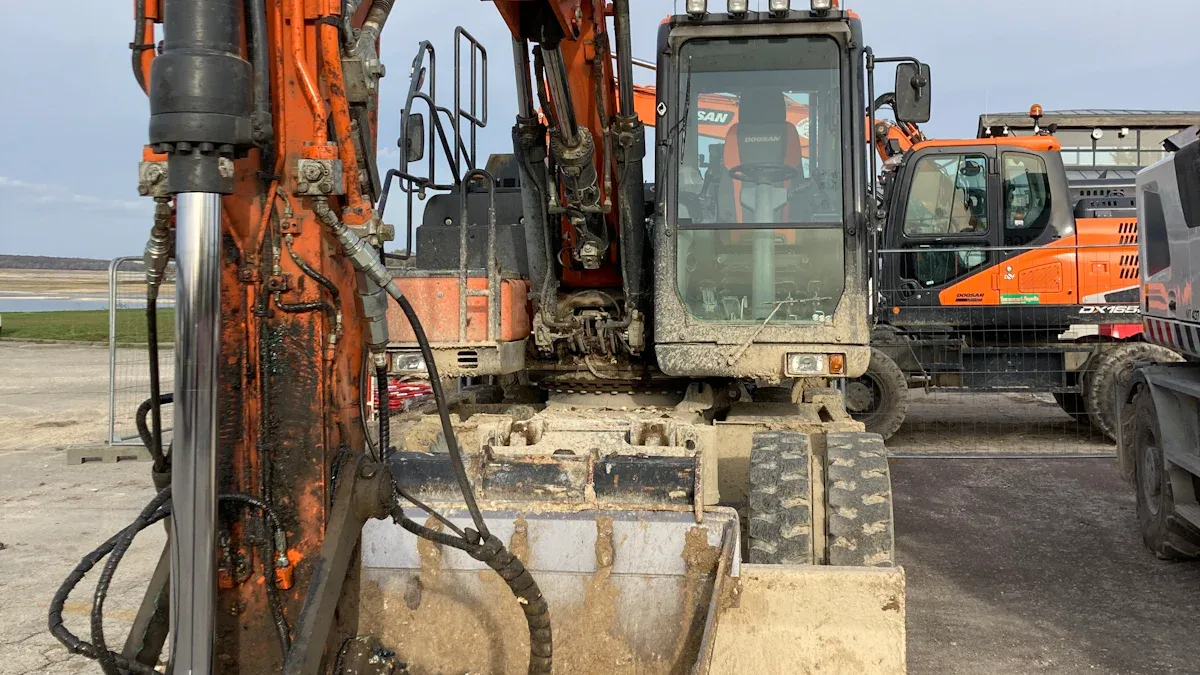
Operator Input
When you sit in the cab, you use joysticks to control the excavator. These joysticks are levers that feel how hard you push. They help you move the boom, arm, bucket, and swing the top part. There are two main ways to set up the controls: ISO and SAE. Each way changes what each joystick does. In ISO, the left joystick moves the stick and swing. The right joystick moves the boom and bucket. In SAE, the left joystick moves the boom and swing. The right joystick moves the stick and bucket.
Component/Control | Description | Function/Action |
|---|---|---|
Levers in the cab | Move boom, stick, bucket, and swing with speed and force control | |
Powered by engine | Pressurizes hydraulic fluid for movement | |
Control Valves | Regulate flow | Direct fluid to cylinders and motors based on joystick input |
Hydraulic Cylinders | Actuators on arm | Turn hydraulic pressure into movement |
Linkages and Pins | Connectors | Allow pivoting and smooth motion |
Control Patterns | ISO/SAE | Decide joystick functions |
Swing Mechanism | Motor and gears | Rotate the upper structure |
When you move a joystick, it sends a signal to the hydraulic system. The engine powers a pump that pushes hydraulic fluid. Control valves send this fluid to the right cylinders or motors. This lets you move each part of the excavator with power and accuracy.
Note: New excavators use smart hydraulics and controls. These systems let you move the boom, arm, and bucket at the same time. You do not lose power. You can work faster and save fuel.
Swing Drive and Rotation
The swing drive lets you turn the top part of the excavator all the way around. It uses a hydraulic swing motor and a gearbox with special gears. These gears turn a pinion. The pinion fits with a big slewing gear that stays still on the undercarriage. When you move the joystick, you control the fluid going to the swing motor. This makes the top part turn smoothly and exactly.
The swing drive is in the middle of the excavator.
Planetary gears give more power for heavy loads.
The pinion and slewing gear work together for full turning.
Safety parts protect the swing drive during hard work.
You can turn the house, boom, and bucket to any spot without moving the tracks. This helps you dig, load, or place things with less work.
Track Motors
Track motors help the excavator move on the ground. Each track has its own hydraulic motor. When you push the travel levers or pedals, you send fluid to these motors. The motors turn the drive sprockets. The sprockets move the tracks forward or backward.
Track motors give strong grip on rough or soft ground.
The undercarriage keeps the machine steady while you work.
Smart hydraulics change track tension and power for better control.
You can steer by sending more power to one track than the other. This lets you turn in small spaces or spin in place. Good track systems and small designs help you move safely and easily on any job site.
Task Execution
Boom, Arm, and Bucket Coordination
When you use an excavator, you move the boom, arm, and bucket together. These parts must work as a team for smooth digging and lifting. You use joysticks to tell the hydraulic system what to do. The system sends oil to each cylinder based on your moves and the weight on the machine. Special controls and electric parts help adjust the oil flow for every action. This setup lets you dig carefully and not waste energy.
Good teamwork between the boom, arm, and bucket helps you dig better. The system only sends oil where it is needed, so you save fuel. The engine does not have to work too hard, so it lasts longer. New excavators use smart tools like GPS and telematics to help you dig in the right spot and save even more fuel. Some machines can even save energy when you lower the boom, which helps you use less fuel and makes the excavator work better.
Tip: If you learn the controls well, you can dig faster, use less fuel, and make fewer mistakes.
Linkage and Pins
Linkage and pins connect the boom, arm, and bucket. These parts help the machine move smoothly and lift heavy things. Strong linkage and good pins keep the excavator working well for a long time.
Makers design linkage pins to fit each machine. This makes them stronger and last longer.
Heat treatment makes the pins tough for heavy work.
Smooth finishes and hard coatings stop wear and damage.
Thick chrome keeps pins from sticking or wearing out fast.
Good engineering makes sure pins fit right and do not break early.
Strong steel and special metals make pins last longer.
CNC machines cut pins smooth for easy use.
Lubricate and check pins often to stop breakdowns and keep things working.
If you use strong linkage and pins, you get better digging power and spend less time fixing things. Taking care of them also helps you avoid losing time on repairs.
Attachments Integration
You can do more jobs with your excavator by adding attachments. Quick coupler systems let you change tools like buckets, breakers, and grapples fast. There are different types, and each has its own good points.
Coupler Type | How It Works | Advantages | Disadvantages |
|---|---|---|---|
Manual Pin Grabbers | You change attachments by moving pins by hand | Simple, low cost, reliable | You must leave the cab, takes more time |
Manual Couplers | Like pin grabbers, but with extra safety features | Safer, still affordable | Still manual, can be tiring |
Hydraulic Couplers | Uses hydraulics to switch attachments from inside the cab | Fast, safe, no need to leave the cab | Costs more, needs regular maintenance |
Some brands, like OilQuick, let you change both mechanical and hydraulic tools from inside the cab in seconds. You do not need to touch hoses, so you stay safe and do not spill oil. These systems use sensors and locks to keep attachments secure. You can work faster and do more jobs without stopping the machine.
Note: Quick couplers make your excavator more useful. You can switch from digging to lifting or breaking rocks without wasting time.
When you use strong linkage, good controls, and quick tool changes, you get the best from your excavator parts inside. You can do many jobs with one machine and keep your work going smoothly.
Your excavator works best when all its parts work as a team. Every system, like hydraulics and the engine, needs to be in good condition. This keeps the machine safe and steady. You should check your excavator often and get training. This helps you find problems early and keep things working well.
If you follow a maintenance plan, you have fewer breakdowns and stay safer.
Maintenance Interval | Key Checks |
|---|---|
Daily | Fluids, tracks, controls, leaks |
Weekly | Battery, belts, hoses, filters |
Monthly | Engine, transmission, electronics |
Knowing how these systems work together helps you stay safe and do a better job.
FAQ
What happens if one excavator part fails?
If one part fails, the whole machine can stop working. For example, a broken hydraulic hose can stop the boom and bucket. You should check your excavator often to catch problems early.
How do you keep excavator parts working together smoothly?
You should follow a regular maintenance plan. Check fluids, clean filters, and inspect pins and hoses. Lubricate moving parts. This helps all systems work as a team.
Can you use different attachments on the same excavator?
Yes, you can use many attachments like buckets, breakers, or grapples. Quick couplers help you switch tools fast. This makes your excavator more useful for different jobs.
Why does the hydraulic system matter so much?
The hydraulic system gives power to the boom, arm, and bucket. It lets you move heavy loads with control. Clean fluid and good hoses keep the system strong.
What is the best way to learn excavator controls?
Tip: Practice in a safe area first. Read the manual and watch training videos. Try moving each part slowly. You will get better with time and practice.
